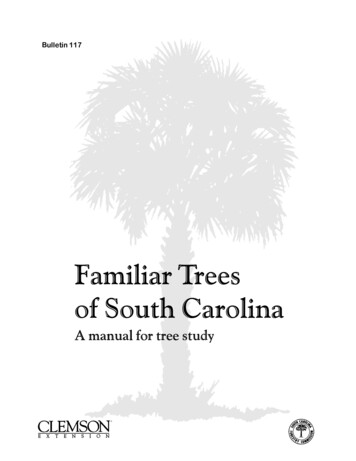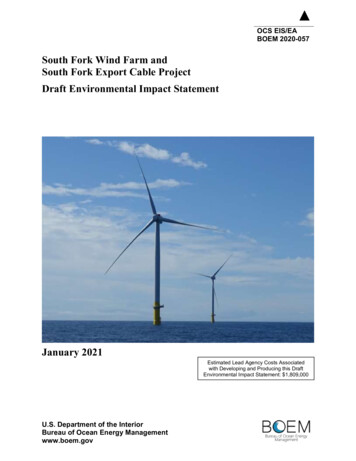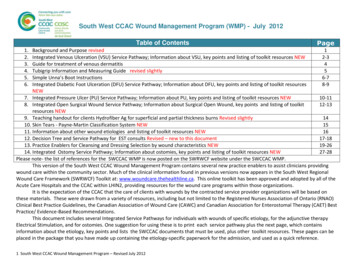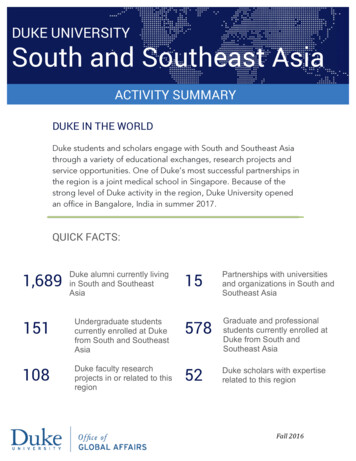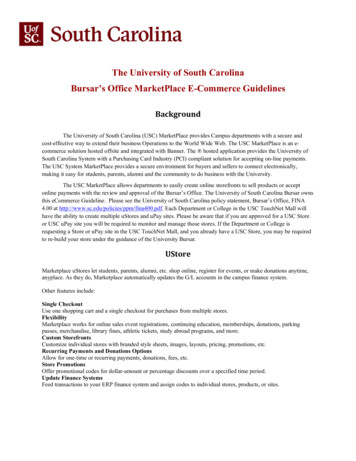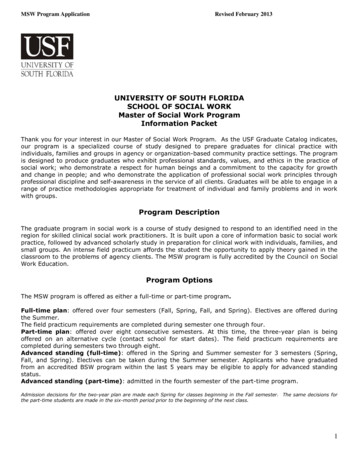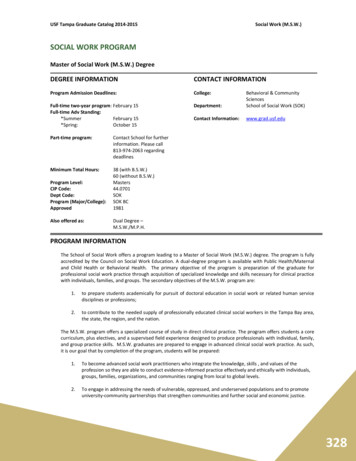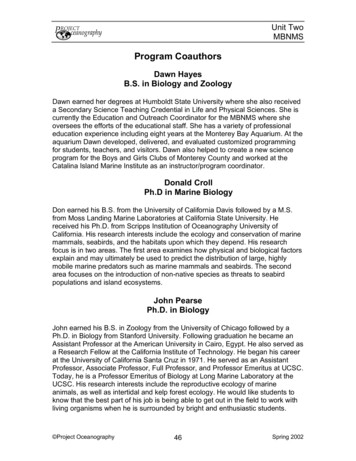
Transcription
Unit TwoMBNMSProgram CoauthorsDawn HayesB.S. in Biology and ZoologyDawn earned her degrees at Humboldt State University where she also receiveda Secondary Science Teaching Credential in Life and Physical Sciences. She iscurrently the Education and Outreach Coordinator for the MBNMS where sheoversees the efforts of the educational staff. She has a variety of professionaleducation experience including eight years at the Monterey Bay Aquarium. At theaquarium Dawn developed, delivered, and evaluated customized programmingfor students, teachers, and visitors. Dawn also helped to create a new scienceprogram for the Boys and Girls Clubs of Monterey County and worked at theCatalina Island Marine Institute as an instructor/program coordinator.Donald CrollPh.D in Marine BiologyDon earned his B.S. from the University of California Davis followed by a M.S.from Moss Landing Marine Laboratories at California State University. Hereceived his Ph.D. from Scripps Institution of Oceanography University ofCalifornia. His research interests include the ecology and conservation of marinemammals, seabirds, and the habitats upon which they depend. His researchfocus is in two areas. The first area examines how physical and biological factorsexplain and may ultimately be used to predict the distribution of large, highlymobile marine predators such as marine mammals and seabirds. The secondarea focuses on the introduction of non-native species as threats to seabirdpopulations and island ecosystems.John PearsePh.D. in BiologyJohn earned his B.S. in Zoology from the University of Chicago followed by aPh.D. in Biology from Stanford University. Following graduation he became anAssistant Professor at the American University in Cairo, Egypt. He also served asa Research Fellow at the California Institute of Technology. He began his careerat the University of California Santa Cruz in 1971. He served as an AssistantProfessor, Associate Professor, Full Professor, and Professor Emeritus at UCSC.Today, he is a Professor Emeritus of Biology at Long Marine Laboratory at theUCSC. His research interests include the reproductive ecology of marineanimals, as well as intertidal and kelp forest ecology. He would like students toknow that the best part of his job is being able to get out in the field to work withliving organisms when he is surrounded by bright and enthusiastic students. Project Oceanography46Spring 2002
Unit TwoMBNMSGeorge MatsumotoPh.D. in Marine BiologyGeorge earned a B.A. degree with a Marine Biology emphasis from theUniversity of California at Berkeley followed by a Ph.D. from the University ofCalifornia Los Angeles. He is currently an Education and Research Specialist atthe Monterey Bay Aquarium Research Institute where he is involved in manyaspects of educational program development. His prior career experienceincludes three years of teaching Marine Biology at Flinders University of SouthAustralia. George continues to stay involved with educational endeavorsincluding marine science programs for K-12 students, a marine science teachereducation program, and a scientists and teachers educational partnership. Hisresearch interests include the open ocean and deep-sea communities withparticular emphasis on invertebrates. His specific areas of interest include:ecology and biogeography of open ocean and deep sea organisms; functionalmorphology, natural history, and behavior of pelagic and benthic organisms; andsystematics and evolution of ctenophores and cnidarians.Jim BarryPh.D. in OceanographyJim earned his B.A. in Zoology from San Jose State University in San Jose,California followed by a M.A. in Biology (Marine Science/Wetlands Biology). Hereceived his Ph.D. in Oceanography from the Scripps Institution ofOceanography of the University of California at La Jolla. Jim is currently anAssociate Scientist at the Monterey Bay Aquarium Research Institute. He isactively involved in many professional organizations including the AmericanAssociation for the Advancement of Science and the American Society ofLimnology and Oceanography. His research interests include deep-sea biologyand ecology, biological oceanography, the biology and ecology ofchemosynthetic communities, climate change and marine ecosystems, polarecology, and carbon sequestration research. Project Oceanography47Spring 2002
Unit TwoMBNMSUnit II: Monterey Bay National MarineSanctuary (MBNMS)On the cutting edge Personnel at the Monterey Bay National Marine Sanctuary are working closelywith scientists on several research projects. Some researchers are interested inmonitoring ecosystems at the land’s edge or discovering the affects of nutrientupwelling on whale distribution. Other scientists are discovering new worlds inthe oceans depths. They are using autonomous underwater vehicles to explorethe deep canyons of the sanctuary. These areas contain poorly understood coldseep communities. Some scientists are exploring organisms in the water columnwhere new jellies have been discovered. All of these studies are very exciting asnew technology opens the ocean frontiers to new exploration.Introduction to the MBNMSLesson Objectives: Students will be able to do the following: Identify two distinguishing features of the MBNMS Compare and contrast the MBNMS with the CINMS Explain how indicator organisms are used in monitoring projectsKey concepts: sanctuary, biological diversity, interdependence, ecologicalstabilityMBNMS Overviewalong the central California coast. Itincludes the waters of Monterey Bayand the adjacent Pacific Oceanwaters. This area contains 4024nautical miles of open ocean water,extending 348 miles north to southand an average 25 nautical miles outfrom shore. This sanctuary is alsoour nation’s deepest, with asubmarine canyon twice as deep asthe Grand Canyon. The deepestpoint in this canyon is 10,663 feetbelow the water’s surface.Our nation’s largest marinesanctuary is the Monterey BayNational Marine Sanctuary(MBNMS). This sanctuary is located Project OceanographyThe MBNMS was designated in1992 because of its rich physical andbiological diversity and its important48Spring 2002
Unit TwoMBNMScan be found along the rocky shores.Whales migrate through the oceanwaters. Sea otters make their homesin kelp forests. Seabirds are foundalong the sandy beaches andwetland areas.cultural resources. The coastalhabitats rangefrom rockyshores andsteep bluffs tosandy beachesbordered bycliffs. The underwater landscapeincludes geologically importantfeatures such as the North AmericanPlate and the Pacific Plate. Thejunction of these two plates ismarked by the San Andreas Fault.Cold, nutrient-rich water found innearshore habitats is delivered to thesurface by upwelling from lowerdepths. This upwelled watersupports an abundance of organismsin varied habitats like the kelp forestsand fields of sand and mud. The rainof deceased plants and animalsfalling to the seafloor supports awealth of benthic fauna in deepcanyons and on rock walls. Manytypes of animalsuse thesediverseenvironments.Some animals are permanentresidents within the sanctuary whileothers travel through this region onmigratory journeys. Marinemammals, seabirds, fish, sea turtles,and a variety of marineinvertebrates use this area. Sealsand sea lionsCultural resources and artifacts giveus a glimpse into the past. Bystudying shell piles or middens leftby Native Americans, we can moreclearly understand someaspects of daily life.Other artifacts,including theremains of manywrecked ships, tell us about weatherpatterns and human impact onanimal populations. For instance,Europeans settlers arriving in the1700’s hunted sea otters andabalones to use as trade items withthe native inhabitants. In somecases, this was detrimental to theecology of the kelp forest.Today the sanctuary continues toprotect the natural and culturalfeatures within its boundaries whileallowing people to use and enjoy theocean. The sanctuary personnel alsoconduct research, monitor thehabitats, and educate the public tohelp promote stewardship of ouroceans and understanding of theseinterdependent communities.Blue WhalesThe blue whale (Balaenopteramusculus) is the largest mammal onearth weighing up to 150 tons andmeasuring 80 feet in length. Thesewhales are characterized by theirlong, slender body shapes and their Project Oceanographybroad, flat heads. They also haveventral pleats on their throats,chests, and bellies. Their bodies aregenerally a blue-grey color with alight ventral surface. Sometimesphytoplankton called diatoms49Spring 2002
Unit TwoMBNMSmigrations. Unlike the Antarcticpopulation of blue whales that travelfrom polar feeding grounds totemperate and tropical breedinggrounds, the California blue whalepopulation feeds year round. Theymigrate from their winter feedinggrounds in the Gulf of California asfar south as the waters offshore ofCosta Rica to their spring andsummer feeding grounds off centraland southern California. Scientistsdon’t know exactly where thesegiants breed and give birth, butsuspect that theGulf of Californiais an importantwinter nurserygrounds forgrowing calves. Blue whales forageonly on krill, and the krill that theCalifornia blue whales feed upon aremade available through coastalupwelling.attach themselves to the surface ofthe whale. These diatoms make thewhale appear to be a yellowish color.That is why some whalers calledthese whales “sulphur bottoms”.Thesegiants ofthe oceanlive over25 years. They mate and breedbetween 6 and 10 years of age. Thefemales have calves every 2 to 3years. These ocean giants searchthe coastal waters for food. Krill(shrimp-like organisms) are theirmain food. Blue whales are baleenwhales. They have baleen platesmade of a fingernail-like materialcalled keratin. These plates look likefine black hairs, but they are verytough. When a blue whale is ready toeat, it opens its mouthand takes inenormous amounts ofwater. As the mouthcloses the water is strained throughthe baleen plates leaving the foodtrapped in the whale’s mouth. Onewhale can eat up to 4 tons of foodper day. That is about 40 million krill.Scientists are interested in learningmore about how the abundance anddistribution of this food is affected byglobal weather change. In additionthey are looking at how fooddistribution affects the migrationpatterns of the blue whale. Thisfascinating research is using thelatest technology to track whales asthey dive for food. Researchers hopeto learn more about how thisimportant marine foodchain impacts otherfood webs. Thisinformation will helpresearchers identifymanagementstrategies that can protect essentialblue whale habitat.Originally blue whale populationswere estimated to be between200,000 and 300,000. Blue whalepopulations were almost completelydecimated in the early 1900’s withadvances in whaling technology. Therecovery of this long-lived species isvery slow, with their numbersestimated at 5000 today. Scientistsin the MBNMS are interested instudying these creatures for severalreasons. Blue whales pass throughsanctuary waters on their long ocean Project Oceanography50Spring 2002
Unit TwoMBNMSRocky Intertidal Monitoringchanges in the world’s oceans, suchas climate change.Rocky intertidalhabitats arecreated as waterrecedes alongrocky coastlinesduring low tides.Pools are left inthe rock depressions along withmany interesting organisms that liveonly in these areas. Many of theinvertebrates and algae found heremust adjust to changingenvironmental conditions. Some ofthese organisms receive food andnutrients carried by the force ofincoming waves. At the same time,they must resist being swept awayas these waves recede. In addition,these organisms need to remainmoist when water is scarce and beprotected from strong ultravioletrays. They must also keep frombeing eaten by predators that usethe tidepools as a seafood buffet.Monitoring projects generally involvestudying a few key species foundwithin a region. These indicatorspecies are typically important forthe overall health and character ofthe community. They may also besensitive to disturbances, such asharvesting, trampling, pollution, orchanges in weather conditions. Bystudying these organisms, scientistscan gain a broad view of the healthof the oceans. Owl limpets present agood example ofintertidalorganisms suitablefor ecologicalmonitoring.Owl limpets are molluscs with asingle, cap-shaped shell that coversa large foot. This foot is used to clingto and crawl over the rocks. Owllimpets graze on diatoms at nightand hide under ledges during theday as they try to escape birds thatprey on them. Owl limpets arehermaphrodites with a veryinteresting life cycle. Ashermaphrodites, they have bothmale and female reproductive parts.They start life as males and changeto females whenthey get larger.Some of thesefemales grow to beover three and a halfinches in length. These females arealso territorial. They clear sizableareas of all organisms so that a lawnof diatoms can grow and provideSome of the rocky intertidal areaswithin the MBNMS are the focus ofeducational monitoring projects.These projects provide anopportunity forscientists to helpstudentsunderstand theecologicalimportance ofthese communities. These areas areideal for study, because they areeasy to get to and contain a broadarray of specimens. They are locatedat the water’s edge, so they providea timely overview of human impact.In addition, changes taking place inintertidal life can be traced to larger Project Oceanography51Spring 2002
Unit TwoMBNMSthem with food. Consequently, theycreate a patchwork of cleared farms.These farms add structure to thecommunity.decrease in numbers simplifies thecommunity structure, because lessspace is incorporated into farms. Inother areas, such as state beaches,the limpets are protected. Herevisitors frighten away the birds, andowl limpets can thrive in unusuallyhigh numbers. When owl limpets arecommon, but not too abundant, theyadd structure to the community withtheir patchwork farms. They alsoprovide food for sea birds and otheranimals. When they’re too abundant,their farms create large areas thatexclude other organisms.Monitoring thenumbers and sizesof owl limpets canreveal a great dealabout the health ofthe rocky intertidalenvironment. In unprotected areas,people often collect the large limpetsfor food. This activity removes manyfemales from the population. This Project Oceanography52Spring 2002
Unit TwoMBNMSActivity: A Crushing ExperienceEvery habitat is impacted by a variety of factors. These conditionsalso affect the organisms that live within the habitat and in turn canupset the ecological balance. Scientists interested in studying thesecommunities sometimes follow changes over time using monitoringprograms. These programs can help scientists determine trends andgive them an overall picture of changes within the ecosystem.Objectives: Students will be able to do the following:1. Observe human impact within a study area.2. Describe the types of changes that occur within the habitat as a result ofhuman impact.3. Evaluate the results of human impact.Materials: Markers to identify the study areas (Markers could include cones, tape, rope,flags, etc.) Paper and pencil for recording (Cameras could also be used for observation.)Note to Teacher: It is helpful if students have participated in observation types ofexperiments prior to this activity. It may be helpful to review the senses and whatthey can tell us about our environment.Procedure:1. Designate two study areas of approximately equal size and similar habitat.Choose one in a high “human” impact area and the other in a low impactarea. (A path worn by people taking a short cut as opposed to an area fencedoff to foot traffic are good examples.)2. Have students use their senses to make observations about each area. Havethem compile a list of the types of organisms that they find in the study areasand their condition. Have students also make observations about the generalcondition of the habitat. (Encourage them to use all of their senses and lookclosely at the smallest portions of the habitat.)3. After making observations, have the students answer questions about thestudy areas. (The following questions can be used or others can be added.) How many animals were seen in each study area? How many types of animals were seen? What areas did the animals occupy? (Trees, shrubs, grass, soil, puddles,etc.) What was the condition of the habitat? (trampled grass, litter, brokenbranches, etc.) Project Oceanography53Spring 2002
Unit TwoMBNMS 4.5.6.7.Did students notice anything that could be hazardous to the living andnonliving parts of the study areas? (gasoline fumes, thick dust, loudnoises)Have students compile a class list of their observations and their answers tothe questions.Have students discuss the differences found in the two study areas. Havethem evaluate the human impact to the areas.Have students make observations about the study areas over a time period.(Once a day for several weeks, or once a week for several months, etc.)Have students discuss their observations. Is human impact damaging thestudy areas? How? To what degree? Can all the changes in the study areasbe attributed to human impact? Can anything be done to lessen the effects ofhuman impact on the study areas?Possible Extensions:1. Have student use their results to develop a role-play using effectivearguments to convince a governing body (city council, etc.) to developstrategies for lessening human impact in certain areas. Project Oceanography54Spring 2002
Unit TwoMBNMSStudent Information: Sanctuary Monitoringenjoying the tidepools, pleasebe careful when handling theseanimals.The MontereyBay NationalMarineSanctuary(MBNMS) islocated off theCaliforniacoast. It is our nation’s largestand deepest sanctuary. It is arichly diverse place wherevisitors can view animals in avariety of habitats. Along thecoastlines are rocky cliffs andsandy beaches. These areasare home to many animalsincluding seals, sea lions, andendangered birds. Amateurnaturalists can search thetidepools for indicatororganisms, such as limpets andsea stars. These delicatecreatures alert scientists toproblems in the environment.Sometimes they will be the firstto be affected by pollutants orextremes in weather conditions.The tidepools are also home toalgae used as food for otherorganisms and anemones thathunt for tiny shrimps with theirstinging tentacles. Althoughthese animals must be sturdy towithstand Mother Nature, theyare very sensitive when itcomes to humans. If you are Project OceanographyThe open waters of thesanctuary are also alive withfish and marine mammals. Thenearshore kelp forests providehabitat and food for sea otters.Transient giants, including theblue whale, can be seen asthey swim through thesanctuary waters. This whale isthe earth’s largest mammalweighing up to 150 tons. Asthese animals look for food,they strain tons of krill orshrimp-like organisms throughtheir baleen plates. Theseplates look like long black hairs,but they are very sturdy. Thewhale takes in large amounts ofwater and sieves out the krill.As they move through thesanctuary waters, scientistsmonitor them. Theseresearchers are interested inlearning more about whales inorder to help them recover fromoverfishing. In the early 1900’s,the blue whale population wasalmost destroyed by whalers’efficient technology. Today theirnumbers are slowly beginningto recover.55Spring 2002
Unit TwoMBNMSJelliesLesson Objectives: Students will be able to do the following: Distinguish between a polyp and a medusa stage Characterize locomotion and feeding within the true jellies Describe a CubozoanKey Concepts: Cnidarians, classification, medusa, polyp, mesoglea, nematocystsCnidarianspolyp shaped body. Its body lookslike a cylinder. There is a mouth atone end with a muscular foot orpedal disc at the other end. Theseanimals are often sessile stayingattached to a substrate. A jelly withits bell shaped body andlong tentacles is ane
a Secondary Science Teaching Credential in Life and Physical Sciences. She is currently the Education and Outreach Coordinator for the MBNMS where she oversees the efforts of the educational staff. She has a
